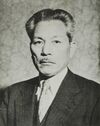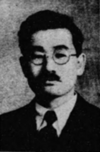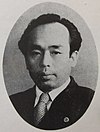Social:Democratic Socialist Party (Japan)
| <div style="padding-top:0.3em; padding-bottom:0.3em; border-top:2px solid Script error: No such module "Political party".; border-bottom:2px solid Script error: No such module "Political party".; line-height: 1;"> Democratic Socialist Party 民主社会党 Minshu Shakai-tō | |
|---|---|
| Founder | Suehiro Nishio |
| Founded | 24 January 1960[1] |
| Dissolved | 9 December 1994[1] |
| Split from | Japan Socialist Party[2] |
| Preceded by | Rightist Socialist Party of Japan (factions) |
| Merged into | New Frontier Party[1] |
| Youth wing | Minsha Youth |
| Ideology | |
| Political position | Centre[4][5][6] to centre-left[7][A] |
| International affiliation | Socialist International |
| Colors | <span style="background-color:Script error: No such module "Political party".; color:; border:1px solid #000000; text-align:center;"> Red |
| Party flag | |
 | |
The Democratic Socialist Party (民主社会党 Minshu Shakai-tō, abbreviated 民社党, Minsha-tō) was a political party in Japan from 1960 to 1994.
History
The party was established in January 1960 by a breakaway faction of the Japanese Socialist Party.[8][9] Led by Suehiro Nishio, it was made up of members of the most moderate wing of the former Rightist Socialist Party of Japan, a moderate faction that had existed as an independent party between 1948 and 1955 before reluctantly merging back together with the Leftist Socialist Party of Japan.[8] Although long-standing ideological differences and factional rivalries played a key role, the proximate cause of the split was internal disagreements over how to conduct the ongoing Anpo protests against revision of the Treaty of Mutual Cooperation and Security Between the United States and Japan, known as Anpo in Japanese, and whether or not to cooperate with the Communist Party of Japan in doing so.[8]
Declassified United States government documents later revealed that covert CIA funding had also helped encourage the founding of this breakaway party.[10] CIA support was aimed at moderating and subverting the political opposition to the ruling conservative Liberal Democratic Party, which was the main CIA funded party.[11][12]
The DSP was dissolved in 1994 to join the New Frontier Party. In 1996, the Japan Socialist Party was transformed into the Social Democratic Party. Two years later, in 1998, the New Frontier Party dissolved and most former DSP members eventually joined the Democratic Party of Japan.[9] Despite the dissolution of the DSP in 1994, its youth organisation (Minsha Youth) survived until 2003 and was a member of the International Union of Socialist Youth (IUSY). After Minsha Youth was dissolved, some of its former members and independent social democrats formed Young Socialists, a new youth organisation which retained full membership in IUSY; however, it was finally dissolved on 8 March 2008 without any successor organisation and abandoned its IUSY membership.[citation needed]
The tradition of the DSP is carried on by the Minsha kyōkai (民社協会, Democratic Socialist Group) as a faction within the liberal Democratic Party of Japan, Democratic Party and now centre-right Democratic Party for the People.
Political position and foreign policy
The DSP has claimed that it was an anti-communist party that officially advocated democratic socialism and had a pro-American foreign policy.[2]
The DSP was rated "moderate",[13][14][15] "moderate social-democratic",[16][2] "centrist"[4][5][6] and "centre-left"[7] by Japanese political standards at the time, but at the same time it was also regarded as a "conservative"[3][17][18] political party. It derived much of its financial and organisational support from the Domei private-sector labour confederation, but unlike other social-democratic political parties in Japan, the party was not hostile to accepting neoliberal policies[19] Due to the DSP's syncretic political position, the party's ideology is often referred to as right-wing social democracy (右派社会民主主義).[20]
The DSP strongly backed the Japan–United States alliance.[2] For this reason, the DSP was often called the "right-wing party" in Japan, but because the DSP had a belief in socialist ideals, it was classified as a political "centrist" along with the old Komeito at the time.[21] In addition, the DSP was a member of left-wing Socialist International.[20][22]
Leaders
Election results
House of Representatives
| Election year | Candidates | No. of seats won | Change | Status |
|---|---|---|---|---|
| 1960 | 105 | 17 / 467
<div style="background-color: Script error: No such module "Political party".; width: 4%; height: 100%;"> |
Opposition | |
| 1963 | 59 | 23 / 467
<div style="background-color: Script error: No such module "Political party".; width: 5%; height: 100%;"> |
Opposition | |
| 1967 | 60 | 30 / 486
<div style="background-color: Script error: No such module "Political party".; width: 6%; height: 100%;"> |
Opposition | |
| 1969 | 68 | 31 / 486
<div style="background-color: Script error: No such module "Political party".; width: 6%; height: 100%;"> |
Opposition | |
| 1972 | 65 | 19 / 491
<div style="background-color: Script error: No such module "Political party".; width: 4%; height: 100%;"> |
Opposition | |
| 1976 | 51 | 29 / 511
<div style="background-color: Script error: No such module "Political party".; width: 6%; height: 100%;"> |
Opposition | |
| 1979 | 53 | 35 / 511
<div style="background-color: Script error: No such module "Political party".; width: 7%; height: 100%;"> |
Opposition | |
| 1980 | 50 | 32 / 511
<div style="background-color: Script error: No such module "Political party".; width: 6%; height: 100%;"> |
Opposition | |
| 1983 | 54 | 38 / 511
<div style="background-color: Script error: No such module "Political party".; width: 7%; height: 100%;"> |
Opposition | |
| 1986 | 56 | 26 / 512
<div style="background-color: Script error: No such module "Political party".; width: 5%; height: 100%;"> |
Opposition | |
| 1990 | 44 | 14 / 512
<div style="background-color: Script error: No such module "Political party".; width: 3%; height: 100%;"> |
Opposition | |
| 1993 | 28 | 15 / 511
<div style="background-color: Script error: No such module "Political party".; width: 3%; height: 100%;"> |
Government |
House of Councillors
| Election year | Seats | Status | |
|---|---|---|---|
| Total | Contested | ||
| 1962 | 12 / 250
<div style="background-color: Script error: No such module "Political party".; width: 5%; height: 100%;"> |
5 / 125
<div style="background-color: Script error: No such module "Political party".; width: 4%; height: 100%;"> |
Opposition |
| 1965 | 7 / 250
<div style="background-color: Script error: No such module "Political party".; width: 3%; height: 100%;"> |
3 / 125
<div style="background-color: Script error: No such module "Political party".; width: 2%; height: 100%;"> |
Opposition |
| 1968 | 10 / 250
<div style="background-color: Script error: No such module "Political party".; width: 4%; height: 100%;"> |
7 / 125
<div style="background-color: Script error: No such module "Political party".; width: 6%; height: 100%;"> |
Opposition |
| 1971 | 13 / 252
<div style="background-color: Script error: No such module "Political party".; width: 5%; height: 100%;"> |
6 / 126
<div style="background-color: Script error: No such module "Political party".; width: 5%; height: 100%;"> |
Opposition |
| 1974 | 10 / 252
<div style="background-color: Script error: No such module "Political party".; width: 4%; height: 100%;"> |
5 / 126
<div style="background-color: Script error: No such module "Political party".; width: 4%; height: 100%;"> |
Opposition |
| 1977 | 11 / 252
<div style="background-color: Script error: No such module "Political party".; width: 4%; height: 100%;"> |
6 / 126
<div style="background-color: Script error: No such module "Political party".; width: 5%; height: 100%;"> |
Opposition |
| 1980 | 12 / 252
<div style="background-color: Script error: No such module "Political party".; width: 5%; height: 100%;"> |
6 / 126
<div style="background-color: Script error: No such module "Political party".; width: 5%; height: 100%;"> |
Opposition |
| 1983 | 12 / 252
<div style="background-color: Script error: No such module "Political party".; width: 5%; height: 100%;"> |
6 / 126
<div style="background-color: Script error: No such module "Political party".; width: 5%; height: 100%;"> |
Opposition |
| 1986 | 12 / 252
<div style="background-color: Script error: No such module "Political party".; width: 5%; height: 100%;"> |
5 / 126
<div style="background-color: Script error: No such module "Political party".; width: 4%; height: 100%;"> |
Opposition |
| 1989 | 8 / 252
<div style="background-color: Script error: No such module "Political party".; width: 3%; height: 100%;"> |
3 / 126
<div style="background-color: Script error: No such module "Political party".; width: 2%; height: 100%;"> |
Opposition |
| 1992 | 9 / 252
<div style="background-color: Script error: No such module "Political party".; width: 4%; height: 100%;"> |
4 / 126
<div style="background-color: Script error: No such module "Political party".; width: 3%; height: 100%;"> |
Opposition |
See also
- Blue Labour
- Democratic Socialists '70
- Italian Democratic Socialist Party
- Labor Right
- Seeheimer Kreis
- Social Democratic Party (UK)
- New Fraternity Party
References
- ↑ 1.0 1.1 1.2 "Error: no
|title=specified when using {{Cite web}}" (in ja). The Asahi Shimbun Company. https://kotobank.jp/word/%E6%B0%91%E4%B8%BB%E7%A4%BE%E4%BC%9A%E5%85%9A-140066. - ↑ 2.0 2.1 2.2 2.3 2.4 Taguchi, Fukuji. "Error: no
|title=specified when using {{Cite web}}" (in ja). The Asahi Shimbun Company. https://kotobank.jp/word/%E6%B0%91%E7%A4%BE%E5%85%9A-140042#E6.97.A5.E6.9C.AC.E5.A4.A7.E7.99.BE.E7.A7.91.E5.85.A8.E6.9B.B8.28.E3.83.8B.E3.83.83.E3.83.9D.E3.83.8B.E3.82.AB.29. - ↑ 3.0 3.1 The Politics Of East Asia: China, Japan, Korea. Routledge. 1996. p. 137. ISBN 9781000304718. https://books.google.com/books?id=pxGjDwAAQBAJ&dq=Japan+%22conservative+Democratic+Socialist+Party%22&pg=PT126. "Continuing cooperation between the conservative Liberal Democratic Party (LDP), the New Liberal Club (NLC), and the conservative Democratic Socialist Party (DSP), will probably assure conservative rule for some time to come."
- ↑ 4.0 4.1 The Abe Legacy: How Japan Has Been Shaped by Abe Shinzo. Rowman & Littlefield. 2021. p. 24. ISBN 9781793643315. https://books.google.com/books?id=bQNOEAAAQBAJ&pg=PA24. "A coalition of fragments of the old Japan Socialist Party, the former “centrist” Democratic Socialist Party, and disaffected refugees from the LDP, its mastermind was Ozawa Ichiro, the most formidable of Tanaka Kakuei's disciples."
- ↑ 5.0 5.1 Hiroshima in History and Memory. Cambridge University Press. 1996. p. 137. ISBN 9780521566827. https://books.google.com/books?id=ptgudYEFOM0C&pg=PA137.
- ↑ 6.0 6.1 R. Taggart Murphy, ed (2014). Japan and the Shackles of the Past. Oxford University Press. p. 122. ISBN 9780190213251. https://books.google.com/books?id=7FAgBQAAQBAJ&pg=PA122.
- ↑ 7.0 7.1 Britannica Book of the Year. Encyclopaedia Britannica. 1982. p. 1950.
- ↑ 8.0 8.1 8.2 Kapur, Nick (2018). Japan at the Crossroads: Conflict and Compromise after Anpo. Cambridge, MA: Harvard University Press. pp. 109–113. ISBN 978-0-6749-8442-4. https://books.google.com/books?id=Re5hDwAAQBAJ.
- ↑ 9.0 9.1 Miranda Schreurs (2014). "Japan". Comparative Politics: Interests, Identities, and Institutions in a Changing Global Order. Cambridge University Press. p. 192. ISBN 978-1-139-99138-4. https://books.google.com/books?id=L2jwAwAAQBAJ&pg=PA192.
- ↑ "U.S. admits CIA gave LDP money in 1950s, 1960s". Japan Times. Kyodo News. 20 July 2006. https://www.japantimes.co.jp/news/2006/07/20/national/u-s-admits-cia-gave-ldp-money-in-1950s-1960s/.
- ↑ Hounshell, Blake (30 July 2007). "U.S. admits CIA gave LDP money in 1950s, 1960s". Foreign Policy. https://foreignpolicy.com/2007/07/30/japans-liberal-democratic-party-was-once-neither-nor/.
- ↑ Weiner, Tim (9 October 1994). "C.I.A. Spent Millions to Support Japanese Right in 50's and 60's". The New York Times. https://query.nytimes.com/gst/fullpage.html?res=9C0DE2DA113DF93AA35753C1A962958260.
- ↑ Robert E. Cole, ed (2022). Japanese Blue Collar: The Changing Tradition. Univ of California Press. p. 18. ISBN 9780520310650. https://books.google.com/books?id=hktpEAAAQBAJ&pg=PA18.
- ↑ United States. Congress. House. Committee on Foreign Affairs. Subcommittee on Asian and Pacific Affairs, ed (1996). United States-Japan Relations: Hearings Before the Subcommittees on Asian and Pacific Affairs and on International Economic Policy and Trade of the Committee on Foreign Affairs, House of Representatives, Ninety-eighth Congress, Second Session, May 2, 3, 23; June 12, 1984. U.S. Government Printing Office. p. 444. https://books.google.com/books?id=R8zQjAozXJQC&pg=PA444. "This year the moderate Democratic Socialist Party has also called for abolition of the one percent ceiling and the setting of a new, more realistic limit."
- ↑ William D. Hoover, ed (2018). Historical Dictionary of Postwar Japan. Rowman & Littlefield. p. 160. ISBN 9781538111567. https://books.google.com/books?id=jyx1DwAAQBAJ&pg=PA160. "... Dōmei was a supporter of the more moderate Democratic Socialist Party while Sōhyō members generally supported the Japan Socialist Party."
- ↑ Comparative Politics: Interests, Identities, and Institutions in a Changing Global Order. Cambridge University Press. 2014. p. 192. ISBN 9780521135740.
- ↑ Cite error: Invalid
<ref>tag; no text was provided for refs namedConservative 2 - ↑ Tomohito Shinoda, ed (1994). Struggle to Lead: The Japanese Prime Minister's Power and His Conduct of Economic Policy. Johns Hopkins University. p. 228. "The conservative Democratic Socialist Party agreed to further discuss the tax reform, while the Japan Socialist Party, the Japan Communist Party, and the Kômeitô demanded the dissolution of the lower house before the reform could be introduced."
- ↑ 及川智洋 (March 2019). "第5章 第3節 民社党---社会党から分裂した社民主義政党が、反共の新自由主義政党へ". 戦後革新勢力の対立と分裂. 法政大学 博士論文(政治学) 32675甲第451号. 法政大学 (Hosei University). doi:10.15002/00021756. https://doi.org/10.15002/00021756.
- ↑ 20.0 20.1 Ian Neary, ed (2005). War, Revolution and Japan. Routledge. p. 140. "The Democratic Socialist Party (DSP) was a right-wing social democratic party, founded by the separation from the SP in I960, and a member of the Socialist International."
- ↑ Albrecht Rothacher, ed (2016). The Japanese Power Elite. Springer. p. 121. ISBN 9781349229932. https://books.google.com/books?id=MQC_DAAAQBAJ&pg=PA121.
- ↑ James C. Docherty; Peter Lamb (2006). Historical Dictionary of Socialism. Scarecrow Press. p. 187. ISBN 978-0-8108-6477-1. https://books.google.com/books?id=JRYjU-L4F7wC&pg=PA187. Retrieved 28 January 2013.
 |




